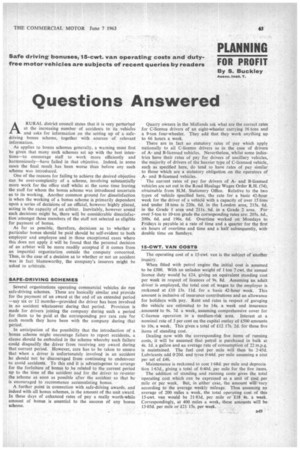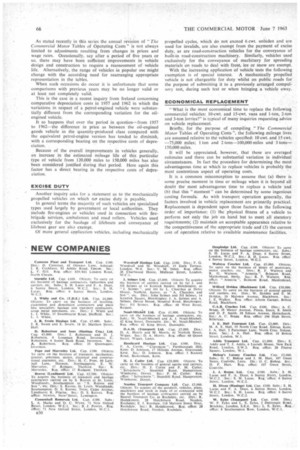Questions Answered
Page 67

Page 68

If you've noticed an error in this article please click here to report it so we can fix it.
ARURAL district council states that it is very perturbed at the increasing number of accidents to its vehicles and asks for information on the setting up of a safedriving bonus scheme, together with sources of relevant information.
As applies to bonus schemes generally, a warning must first be given that many such schemes set up with the best intentions-to encourage staff to work more efficiently and harmoniously-have failed in that objective. Indeed, in some cases the final result has been worse than before any such scheme was introduced.
One of the reasons for failing to achieve the desired objective can be over-complexity of a scheme, involving substantially more work for the office staff whilst at the same time leaving the staff for whom the bonus scheme was introduced uncertain as to its working. Another common ground for dissatisfaction is when the working of a bonus scheme is primarily dependent upon a series of decisions of an official, however highly placed, acting in the capacity of an arbiter. Inevitably, however sound such decisions might be, there will be considerable dissatisfaction amongst those members of the staff not selected as eligible for payment of bonus.
As far as possible, therefore, decisions as to whether a particular bonus should be paid should be self-evident to both employer and employee and in those exceptional cases where this does not apply it will be found that the personal decision of an arbiter will be more readily accepted if it comes from an impartial organization outside the company concerned. Thus, in the case of a decision as to whether or not an accident was in fact blameworthy, the company's insurers might be asked to arbitrate.
SAFE-DRIVING SCHEMES Several organizations operating commercial vehicles do run safe-driving schemes. These are basically similar and provide for the payment of an award at the end of an extended period -say six or 12 months-provided the driver has been involved in no accident whatsoever during that period. Provision is made for drivers joining the company during such a period for them to be paid at the corresponding pro rata rate for each month they have been with the company during that period.
In anticipation of the possibility that the introduction of a bonus scheme might encourage failure to report accidents, a clause should be embodied in the scheme whereby such failure could disqualify the driver from receiving any award during that current period. However, care has to be taken to ensure that when a driver is unfortunately involved in an accident he should not be discouraged from continuing to endeavour to avoid accidents. To this end it is advantageous to arrange for the forfeiture of bonus to be related to the current period up to the time of the accident and for the driver to re-enter the scheme as soon as possible after the accident so that he is encouraged to recommence accumulating bonus.
A further point in connection with safe-driving awards, and indeed with all bonus schemes, is the amount of the unit award. In these days of enhanced rates of pay a really worth-while amount of bonus is essential to the success of any bonus scheme. Quarry owners in the Midlands ask what are the correct rates for C-licence drivers of an eight-wheeler carrying 16 tons and a 9-ton four-wheeler. They add that they work anything up to 66 hours a week.
There are in fact no statutory rates of pay which apply nationally to all C-licence drivers as in the case of drivers of Aand B-licensed vehicles. Nevertheless, whilst some industries have their rates of pay for drivers of ancillary vehicles, the majority of drivers of the heavier type of C-licensed vehicle, such as specified here, do tend to have rates of pay similar to those which are a statutory obligation on the operators of Aand B-licensed vehicles.
The current rates of pay for drivers of Aand B-licensed vehicles are set out in the Road Haulage Wages Order R.H. (74), obtainable from RM. Stationery Office. Relative to the two types of vehicle specified here, the rate for a basic 42-hour week for the driver of a vehicle with a capacity of over 15 tons and under 18 tons is 220s. 6d. in the London area, 215s. 6d. in the Grade 1 area and 211s. 6d. in a Grade 2 area. For over 5-ton to 10-ton grade the corresponding rates are: 205s. 6d., 200s. 6d. and 196s. 6d. Overtime worked on Mondays to Fridays is payable at a rate of time and a quarter for the first six hours of overtime and time and a half subsequently, with double time on Sundays.
15-CWT. VAN COSTS The operating cost of a 15-cwt. van is the subject of another inquiry.
When fitted with petrol engine the initial cost is assumed to be £500. With an unladen weight of 1 ton 7 cwt. the annual licence duty would be £24, giving an equivalent standing cost per week in respect of licences of 9s. 8d. Assuming an adult driver is employed, the total cost of wages to the employer is reckoned at £10 13s. lid, for a basic 42-hour week. This amount is inclusive of insurance contributions and an allowance for holidays with pay. Rent and rates in respect of garaging the vehicle are estimated to be 14s. a week and insurance amountt to 9s. 7d. a week, assuming comprehensive cover for C-licence operation in a medium-risk area. Interest at a nominal rate of 5 per cent on the capital outlay of £500 amounts to 10s. a week. This gives a total of £12 17s. 2d. for these five items of standing cost.
Dealing now with the corresponding five items of running costs, it will be assumed that petrol is purchased in bulk at 4s. Id. a gallon and an average rate of consumption of 22 m.p.g. is maintained. The fuel cost per mile will then be 2.45d. Lubricants add 0.20d. and tyres 0.44d. per mile assuming a cost per set of £46.
Maintenance is reckoned to cost 1.68d. per mile and deprecia tion 1.63d., giving a total of 6-40d. per mile for the five items.
The addition of standing and running costs gives the total operating cost which can be expressed as a unit of cost per mile or per week. But, in either case, the amount will vary according to the average weekly mileage. Thus assuming an average of 200 miles a week, the total operating cost of this 15-cwt. van would be 21-83d. per mile or 118 4s. a week. Correspondingly, at 400 miles a week, these amounts will be 13-05d. per mile or £21 15s. per week.
As stated recently in this series the annual revision of "The Cotrunercial Motor Tables of Operating Costs" is not always limited to adjustments resulting from changes in prices and wage rates. Occasionally, say after a period of five years or so, there may have been sufficient improvements in vehicle design and construction to require a reassessment of vehicle life. Alternatively, the range of vehicles in popular use might change with the according need for rearranging appropriate representation in the tables.
When such occasions do occur it is unfortunate that some comparisons with previous years may be no longer valid or at least not completely valid.
This is the case in a recent inquiry from Ireland concerning comparative depreciation costs in 1957 and 1962 in which the variations in respect of a petrol-engined vehicle were substantially different from thc corresponding variation for the oilengined vehicle.
It so happens that over the period in question—from 1957 to 1962—the difference in price as between the oil-engined goods vehicle in the quantity-produced class compared with the equivalent petrol-engine version has tended to diminish, with a corresponding bearing on the respective costs of depreciation.
Because of the overall improvements in vehicles generally, an increase in the estimated mileage life of this particular type of vehicle from 120,000 miles to 150,000 miles has also been considered justified during that period. Here again this factor has a direct bearing in the respective costs of depreciation.
EXCISE DUTY Another inquiry asks for a statement as to the mechanically propelled vehicles on which no excise duty is payable.
In general terms the majority of such vehicles are specialized types used largely by government or local authorities. They include fire-engines or vehicles used in connection with firebrigade services, ambulances and road rollers. Vehicles used exclusively for the haulage of lifeboats and conveyance of lifeboat gear are also exempt.
Of more general application vehicles, including mechanically
propelled cycles, which do not exceed 6 cwt. unladen and are used for invalids, are also exempt from the payment of excise duty, as are road-construction vehicles for the conveyance of built-in road-construction machinery. Similarly, vehicles used exclusively for the conveyance of machinery for spreading materials on roads to deal with frost, ice or snow are exempt.
With the increasing application of vehicle tests the following exemption is of special interest. A mechanically propelled vehicle is not chargeable for duty whilst on public roads for the purpose of submitting it to a previously arranged compulsory test, during such test or when bringing a vehicle away.
ECONOMICAL REPLACEMENT " What is the most economical time to replace the following commercial vehicles: 10-cwt. and 15-cwt. vans and 1-ton, 2-ton and 3-ton lorries?" is typical of many inquiries requesting advice on vehicle replacement.
Briefly, for the purpose of compiling "The Commercial Motor Tables of Operating Costs", the following mileage lives are assumed relative to the vehicles specified: 10 cwt. and 15 cwt. —75,000 miles; 1 ton and 2 tons-100,000 miles and 3 tons150.000 miles.
It will be appreciated, however, that these are averaged estimates and there can be substantial variation in individual circumstances. In fact the procedure for determining the most advantageous time at which to replace vehicles is probably the most contentious aspect of operating costs.
It is a common misconception to assume that (a) there is some precise moment in time or mileage when it is beyond all doubt the most advantageous time to replace a vehicle and (b) that this " moment " can be determined by some ingenious costing formula. As with transport operation generally, the factors involved in vehicle replacement are primarily practical. Replacement is dependent upon three factors in the following order of importance; (I) the physical fitness of a vehicle to perform not only the job on hand but to meet all statutory requirements; (2) maintain an acceptable appearance relative to the competitiveness of the appropriate trade and (3) the current cost of operation relative to available maintenance facilities.




































































































